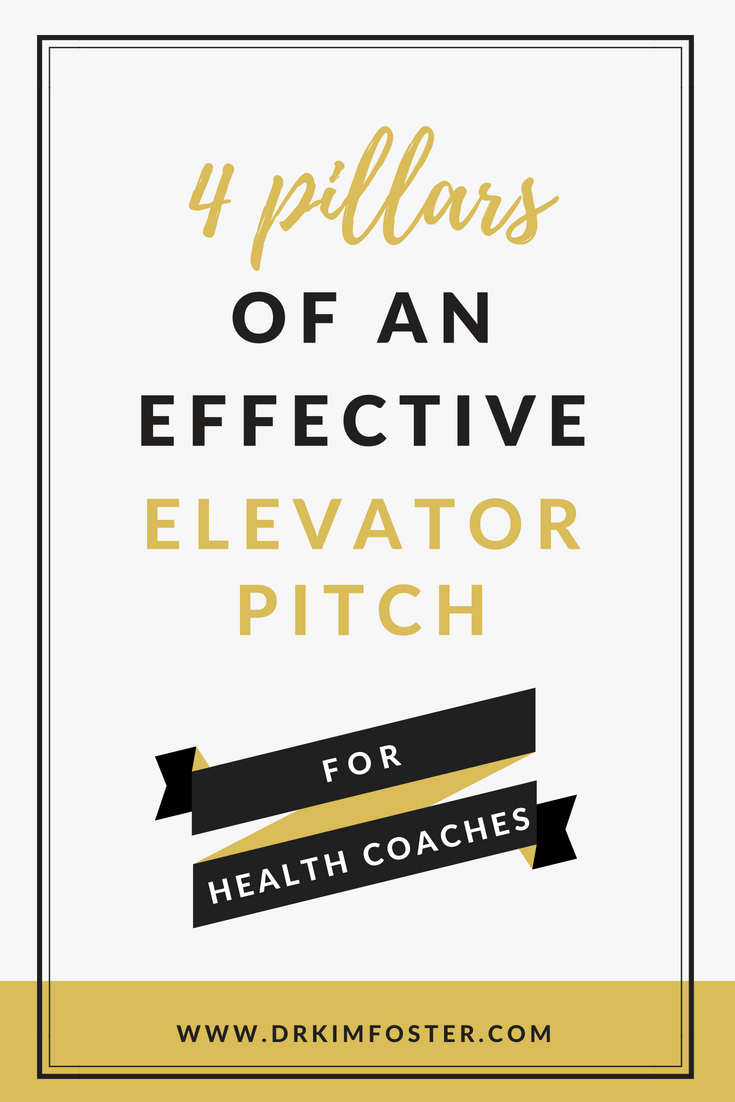Are you a health coach confused about how to give an “elevator pitch” of your business? When you get the opportunity to pitch yourself, face-to-face, are you like a deer in the headlights?
No sweat — I’ve got a very simple formula that will have you poised and polished the next time you find yourself in this situation.
In this article I’m going to outline the 4 PILLARS of a perfect pitch…so keep reading! (Or, go ahead and watch the video below, if you prefer that format.)
Thing is, even if your main goal is to build your health coaching business online, sooner or later there will come a time when you are in a position to pitch yourself, face-to-face. Like when you’re at a conference, or when you meet an influencer or potential collaborator, or when you’re intentionally approaching other professionals for referrals.
These kinds of situations can be wonderful opportunities, and can be a very powerful way to take a quantum leap in your business, and what you don’t want to do is squander them by stumbling over your words, and being like a deer in the headlights.
Not to worry — I’ve got a very simple formula for you to follow, that will have you poised and polished the next time you find yourself in this situation.
I work with a lot of health coaches and it’s a pretty common problem, not knowing how to PITCH yourself properly, in person, stumbling over your words. I hear it a lot.
As for myself, over the years, I have learned the fine art of pitching myself (for media interviews, and other professional collaborations as a physician and a coach)…plus one other fun fact about me is that I’m a novelist (traditionally published) and in the publishing world, pitching is EXTREMELY commonplace. It’s hard to get anywhere without being able to concisely, and effectively pitch yourself and your ideas — to very busy literary agents and editors…and I have had a ton of practice with this, so this is something I can speak to with a high degree of authority.
So let’s dive into this topic. Today we’re going to go over the FOUR pillars of a flawless pitch.
PILLAR ONE: A quick introduction
A key thing to remember is that your pitch is not really about YOU as much as it is about THEM — as in, the person who is listening, and what can you do for that person.
So what I don’t want you to do is start off with a long-winded description of who you are and your whole life story. Right off the bat the person who is listening to you will want to know “what’s in it for them”, and if you start off with an extended backstory…you are probably going to lose them. Their eyes will glaze over…or worse.
So I want you to ask yourself: how can you help this person in some way? Do you have something to offer that would be of value? That’s what people really want to know…whether they come right out and say it or not. So don’t start with a bunch of details about YOU…if they’re interested, they’ll ask you about the details of your credentials and backstory later, or you can find an opportunity to bring it up. But don’t lead with that.
Let’s take an example. Say you meet a fellow health coach at a conference, and you’re familiar with her work, you’ve read a couple of her blog posts, listened to a guest podcast or two, and you feel really aligned and simpatico. You would love to talk to her more, and you’ve got a germ of an idea for collaboration or joint venture. Let’s say her niche is with digestive health and yours is with migraines.
A very simple formula is just to say who you are, describe your position in a couple of words, and then state who you help.
In a nutshell you could introduce yourself with something simple like: “I’m Sarah, I’m a health coach, and I work with women who struggle with chronic migraines.”
PILLAR TWO: create connection and show familiarity
Immediately after you’ve made your introduction, you again want to find another way to keep the focus on them, and try to find some element of connection between you two, no matter how small. If you can find an authentic way to show that you have something in common, it can really go a long way. Maybe you’re aware of a personal interest of theirs, and you share it — so mention that. Or it could be showing that you’re familiar with their work, like how long you’ve been reading their blog, or following them on instagram, or something like that.
Basically, this create connection/show familiarity piece can take on all kinds of qualities, because it entirely depends who you’re talking to…but just try to find a way, after you’ve given your very brief introduction, to find a quick way to make a connection with your listener. Again, this serves to pull them in, to make them really sit up and listen.
Let’s stick with the example of a fellow health coach for a moment, to demonstrate how this second pillar would sound. It might be you saying something like: “I understand you work with clients with digestive issues, and I listened to your podcast about that topic a couple of months ago…” And then you could briefly describe what you liked about it.
PILLAR THREE: pitch your idea
Now it’s time to get to the meat of things. This is basically the moment when you make your offer — whatever that might be. If it’s an offer of collaboration, or a joint venture, this is the moment to put it out there and describe, briefly, what you’ve got in mind.
Again, keep it super brief, intriguing and irresistible. Encapsulate your offer in 1-2 sentences. Like: “I’d love to come on your podcast and talk to your listeners about natural ways to prevent migraines. I know your listeners are mostly women, and it’s a common problem for a lot of women, and I have some not-so-commonly known strategies I could share.”
To take another example, let’s say you’re pitching a doctor, telling her about your services as a health coach in hopes that she’ll refer some of her patients to you.
Make sure you frame your offer in terms of how you are going to solve a problem for the doctor using your services and expertise. Something like: “I know your time is a premium and it’s difficult to spend a lot of time with patients counseling them on the various lifestyle changes that might help prevent their migraines. I offer a one-on-one coaching program that could help offload some of that pressure, and also provide a useful resource for your patients.”
Again, just 1-2 sentences and then stop talking. Give them a chance to respond or ask a question. When I was learning how to do media interviews, one of the things that was emphasized was talking in “sound bites”. Give your piece that should—hopefully—intrigue or hook, and then leave it. Let the interviewer follow up with something else. The worst type of conversation is one where the person goes on in a big run-on sentence, trying to jam as much information in as possible. This is NOT the spirit of an elevator pitch. You’re just going to annoy and turn off your audience, and their eyes will start darting around looking for an escape.
PILLAR FOUR: make the ask!
It may seem glaringly obvious, but you’d be surprised how often this last piece is overlooked. Provide the call to action and put it out there: let it be known that you would love to chat more, and take things to the next step. So this is when you say: “If you’re interested, I’d love the opportunity to talk to you further. Would it be all right if I contacted your office?” Or maybe: “Can I get in touch with you after the conference so we can chat more?”
Let’s RECAP
Okay, so let’s recap the 4 pillars of the perfect pitch:
- A brief, to-the-point introduction
- A moment to create connection or familiarity
- Pitching your idea
- Making the ask
Now, maybe you read this article because you like the idea of approaching other professionals for referrals or collaborations, and want to figure out how to make that happen. And while pitching is important, it’s just one part of the puzzle.
If you’re intrigued by the idea of getting referrals from doctors, in particular…then you may be interested in my free guide for health coaches on how to get MD referrals. Go ahead and grab that PDF by clicking on the thumbnail below.







